Mechanical Properties and Bonding Mechanism of the Mg/Al Clad Sheet Manufactured by the Corrugated Roll
Abstract
1. Introduction
2. Experimental Procedure
2.1. Materials
2.2. Billet Preparation
2.3. Heating before Rolling
2.4. Corrugated Rolling Process
2.5. Microstructure Characterization and Mechanical Properties Tests
3. Results and Discussion
3.1. Interface Morphology
3.2. Mechanical Properties of the Corrugated Mg/Al Clad Sheet
3.2.1. Tensile Properties
3.2.2. Microhardness
3.2.3. Bending Properties
3.3. Interface Bonding Mechanism
4. Conclusions
- After the corrugated rolling process, the interface of the corrugated Mg/Al clad sheet became well combined, and the interfacial metal grains refined significantly due to the strong plastic deformation. The transverse tensile results showed that the maximum UTS of the clad sheet at the trough position was ~296 MPa, while the minimum UTS at the peak position was ~257 MPa. On the contrary, the fracture EL was largest at the peak position (~13.4%), and smallest at the trough position (~10.6%).
- During the transverse tensile process, stress concentration occurred first in the Mg sheet, resulting in uneven stress distribution for both matrixes. As a result, the interface stratified first, then the Mg sheet broke, and finally the clad sheet failed along with the Al sheet fracturing.
- By analyzing the GND density of the matrixes, the strengthening mechanism of the peak position was determined to be mainly dislocation strengthening, while the strengthening mechanism of the trough position was mainly grain boundary strengthening.
- The interface bonding process of corrugated Mg/Al clad sheet can be divided into four stages: extrusion deformation, rubbing fracture, compound extension and compound completion.
Author Contributions
Funding
Institutional Review Board Statement
Informed Consent Statement
Data Availability Statement
Conflicts of Interest
References
- Wasekar, N.P.; Latha, S.M.; Ramakrishna, M.; Rao, D.S.; Sundararajan, G. Pulsed electrodeposition and mechanical properties of Ni-W/SiC nano-composite coatings. Mater. Des. 2016, 112, 140–150. [Google Scholar] [CrossRef]
- Chen, L.; Fu, Y.; Yin, F.; Liu, N.; Liang, C. Microstructure and Mechanical Properties of Mg/Al Clad Bars with Ni Interlayer Processed by Compound Castings and Multi-Pass Caliber Rolling. Metals 2018, 8, 704. [Google Scholar] [CrossRef]
- Ahledel, N.; Schulz, R.; Gariepy, M.; Hermawan, H.; Alamdari, H. Electrochemical Corrosion Behavior of Fe3Al/TiC and Fe3Al-Cr/TiC Coatings Prepared by HVOF in NaCl Solution. Metals 2019, 9, 437. [Google Scholar] [CrossRef]
- Wachowski, M.; Kosturek, R.; Sniezek, L.; Mroz, S.; Stefanik, A.; Szota, P. The Effect of Post-Weld Hot-Rolling on the Properties of Explosively Welded Mg/Al/Ti Multilayer Composite. Materials 2020, 13, 1930. [Google Scholar] [CrossRef]
- Nie, H.H.; Liang, W.; Chen, H.S.; Zheng, L.W.; Chi, C.Z.; Li, X.R. Effect of annealing on the microstructures and mechanical properties of Al/Mg/Al laminates. Mater. Sci. Eng. A. 2018, 732, 6–13. [Google Scholar] [CrossRef]
- Zhang, N.; Wang, W.X.; Cao, X.Q.; Wu, J.Q. The effect of annealing on the interface microstructure and mechanical characteristics of AZ31B/AA6061 composite plates fabricated by explosive welding. Mater. Des. 2015, 65, 1100–1109. [Google Scholar] [CrossRef]
- Qi, Z.C.; Yu, C.; Xiao, H. Microstructure and bonding properties of magnesium alloy AZ31/CP-Ti clad plates fabricated by rolling bonding. J. Manuf. Process. 2018, 32, 175–186. [Google Scholar] [CrossRef]
- Nemcko, M.J.; Qiao, H.; Wu, P.D.; Wilkinson, D.S. Effects of void fraction on void growth and linkage in commercially pure magnesium. Acta. Mater. 2016, 113, 68–80. [Google Scholar] [CrossRef]
- Yang, M.; Liu, X.B.; Zhang, Z.Y.; Song, Y.L. Stress Corrosion Behavior of AM50Gd Magnesium Alloy in Different Environments. Metals 2019, 9, 616. [Google Scholar] [CrossRef]
- Feng, G.; Watari, H.; Haga, T. Fabrication of Mg/Al Clad Strips by Direct Cladding from Molten Metals. Metals 2022, 12, 1408. [Google Scholar] [CrossRef]
- Wang, Y.; Liao, Y.; Wu, R.; Turakhodjaev, N.; Chen, H.; Zhang, J.; Zhang, M.; Mardonakulov, S. Microstructure and mechanical properties of ultra-lightweight Mg-Li-Al_Al-Li composite produced by accumulative roll bonding at ambient temperature. Mater. Sci. Eng. A. 2020, 787, 139494. [Google Scholar] [CrossRef]
- Nie, H.; Liang, W.; Chen, H.; Wang, F.; Li, T.; Chi, C.; Li, X.r. A coupled EBSD/TEM study on the interfacial structure of Al/Mg/Al laminates. J. Alloy. Compd. 2019, 781, 696–701. [Google Scholar] [CrossRef]
- Nie, H.; Liang, W.; Zheng, L.; Ren, X.; Chi, C.; Fan, H. The Microstructure, Texture and Mechanical Properties of the Rolled Al/Mg/Al Clad Sheets. J Mater. Eng. Perform. 2016, 25, 4695–4705. [Google Scholar] [CrossRef]
- Chang, H.; Zheng, M.Y.; Xu, C.; Fan, G.D.; Brokmeier, H.G.; Wu, K. Microstructure and mechanical properties of the Mg/Al multilayer fabricated by accumulative roll bonding (ARB) at ambient temperature. Mater. Sci. Eng. A. 2012, 543, 249–256. [Google Scholar] [CrossRef]
- Chang, H.; Zheng, M.Y.; Gan, W.M.; Wu, K.; Maawad, E.; Brokmeier, H.G. Texture evolution of the Mg/Al laminated composite fabricated by the accumulative roll bonding. Scripta. Mater. 2009, 61, 717–720. [Google Scholar] [CrossRef]
- Thangapandian, N.; Balasivanandha Prabu, S.; Padmanabhan, K.A. Effects of die profile on grain refinement in Al–Mg alloy processed by repetitive corrugation and straightening. Mater. Sci. Eng. A 2016, 649, 229–238. [Google Scholar] [CrossRef]
- Bhovi, P.M.; Patil, D.C.; Kori, S.A.; Venkateswarlu, K.; Huang, Y.; Langdon, T.G. A comparison of repetitive corrugation and straightening and high-pressure torsion using an Al-Mg-Sc alloy. J. Mater. Res. Technol. 2016, 5, 353–359. [Google Scholar] [CrossRef]
- Wang, T.; Li, S.; Ren, Z.; Han, J.; Huang, Q. A novel approach for preparing Cu/Al laminated composite based on corrugated roll. Mater. Lett. 2019, 234, 79–82. [Google Scholar] [CrossRef]
- Wang, T.; Wang, Y.; Bian, L.; Huang, Q. Microstructural evolution and mechanical behavior of Mg/Al laminated composite sheet by novel corrugated rolling and flat rolling. Mater. Sci. Eng. A 2019, 765, 138318. [Google Scholar] [CrossRef]
- Tang, J.W.; Chen, L.; Zhao, G.Q.; Zhang, C.S.; Yu, J.Q. Study on Al/Mg/Al sheet fabricated by combination of porthole die co-extrusion and subsequent hot rolling. J. Alloy. Compd. 2019, 784, 727–738. [Google Scholar] [CrossRef]
- Tang, J.; Chen, L.; Zhao, G.; Zhang, C.; Sun, L. Achieving three-layered Al/Mg/Al sheet via combining porthole die co-extrusion and hot forging. J. Magnes. Alloy. 2020, 8, 654–666. [Google Scholar] [CrossRef]
- Ateba Betanda, Y.; Helbert, A.-L.; Brisset, F.; Mathon, M.-H.; Waeckerlé, T.; Baudin, T. Measurement of stored energy in Fe–48%Ni alloys strongly cold-rolled using three approaches: Neutron diffraction, Dillamore and KAM approaches. Mater. Sci. Eng. A 2014, 614, 193–198. [Google Scholar] [CrossRef]
- Kubin, L.P.; Mortensen, A. Geometrically necessary dislocations and strain-gradient plasticity: A few critical issues. Scripta. Mater. 2003, 48, 119–125. [Google Scholar] [CrossRef]
- Gao, H.; Huang, Y.; Nix, W.D.; Hutchinson, J.W. Mechanism-based strain gradient plasticity-I. Theory. J. Mech. Phys. Solids. 1999, 47, 1239–1263. [Google Scholar] [CrossRef]
- Wan, Y.; Tang, B.; Gao, Y.; Tang, L.; Sha, G.; Zhang, B.; Liang, N.; Liu, C.; Jiang, S.; Chen, Z.; et al. Bulk nanocrystalline high-strength magnesium alloys prepared via rotary swaging. Aata. Mater. 2020, 200, 274–286. [Google Scholar] [CrossRef]
- Kalsar, R.; Yadav, D.; Sharma, A.; Brokmeier, H.G.; May, J.; Höppel, H.W.; Skrotzki, W.; Suwas, S. Effect of Mg content on microstructure, texture and strength of severely equal channel angular pressed aluminium-magnesium alloys. Mater. Sci. Eng. A 2020, 797, 140088. [Google Scholar] [CrossRef]
- Lee, J.H.; Lee, J.U.; Kim, S.-H.; Song, S.W.; Lee, C.S.; Park, S.H. Dynamic recrystallization behavior and microstructural evolution of Mg alloy AZ31 through high-speed rolling. J. Mater. Sci. Technol. 2018, 34, 1747–1755. [Google Scholar] [CrossRef]
- Wang, T.; Liu, W.; Liu, Y.; Wang, Z.; Ignatov, A.V.; Huang, Q. Formation mechanism of dynamic multi-neutral points and cross shear zones in corrugated rolling of Cu/Al laminated composite. J. Mater. Process. Tech. 2021, 295, 117157. [Google Scholar] [CrossRef]

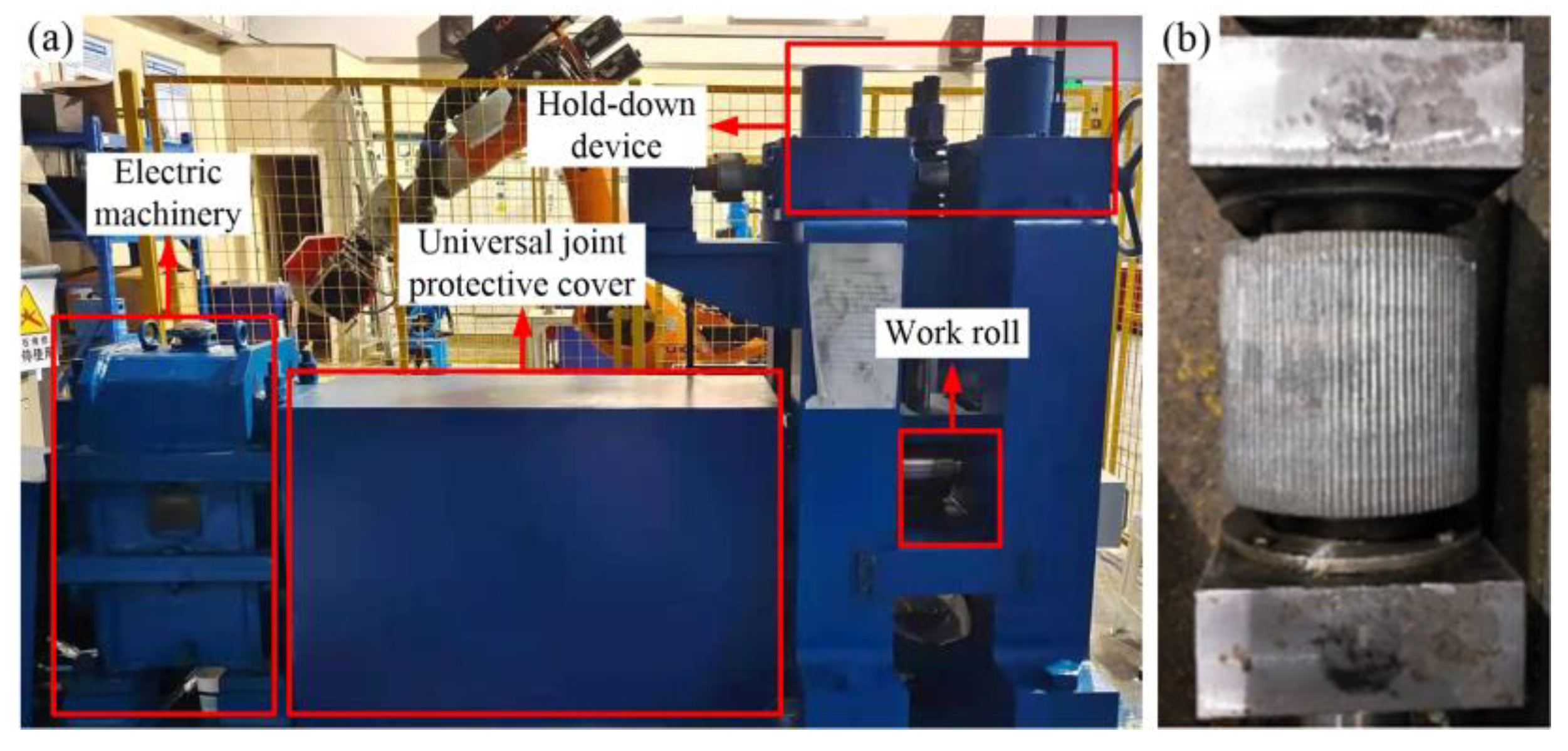
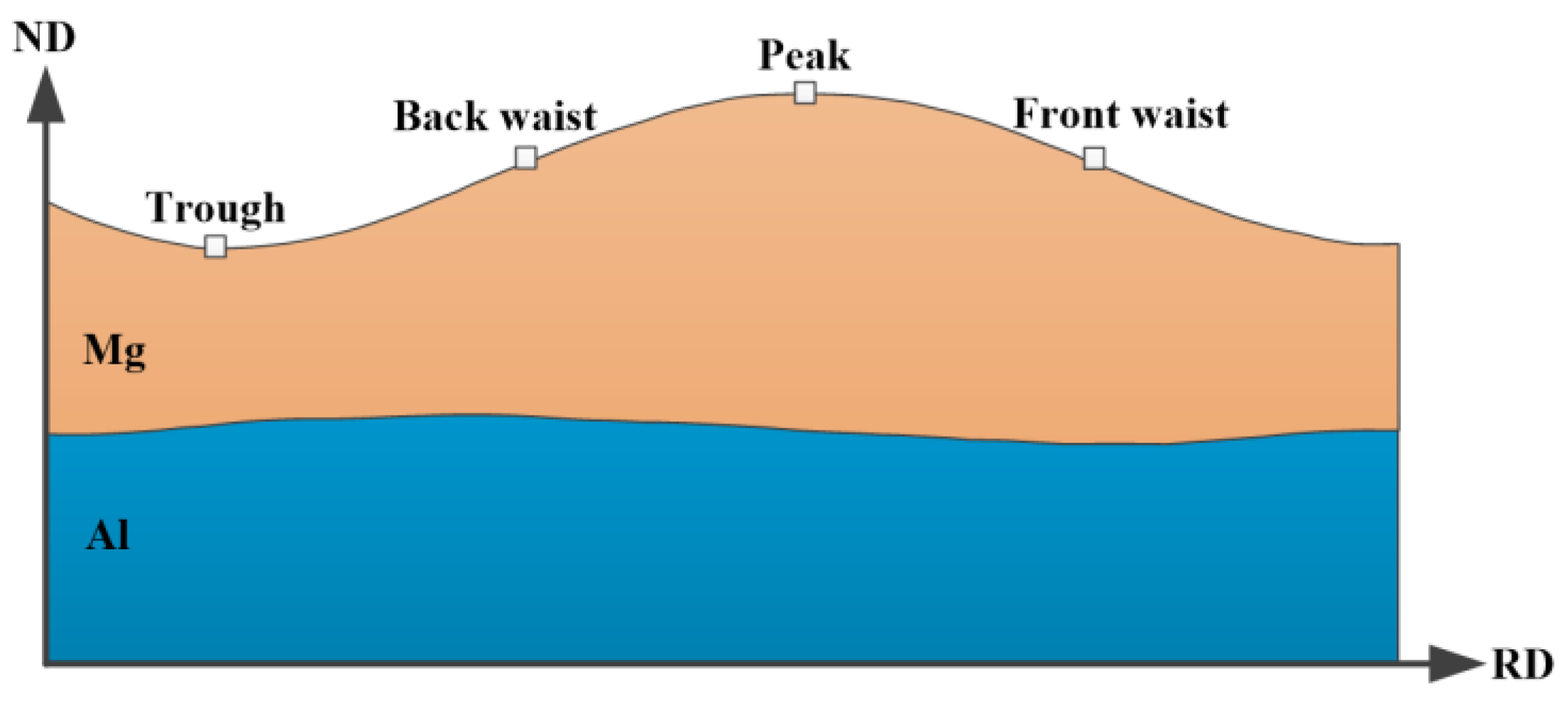

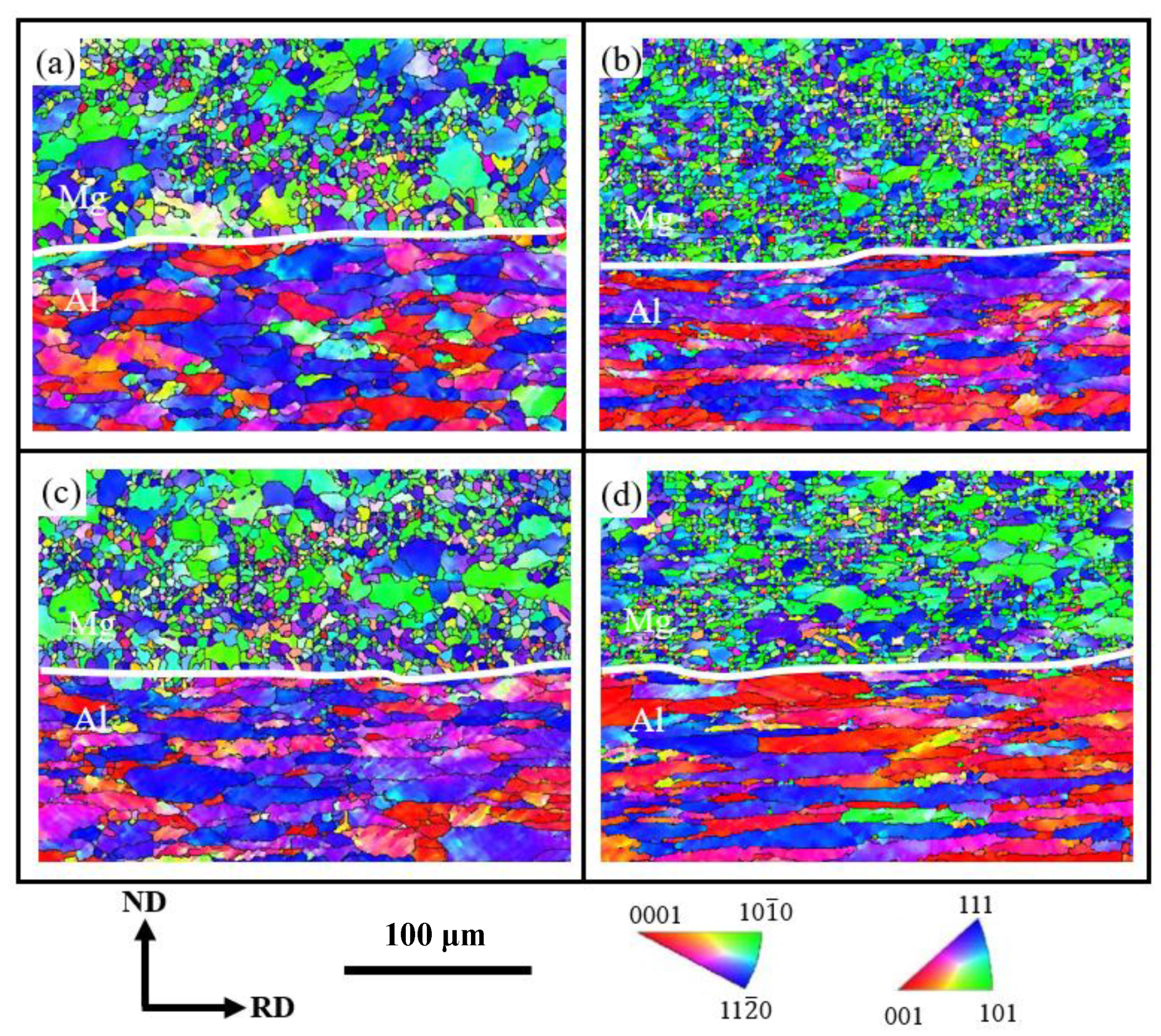
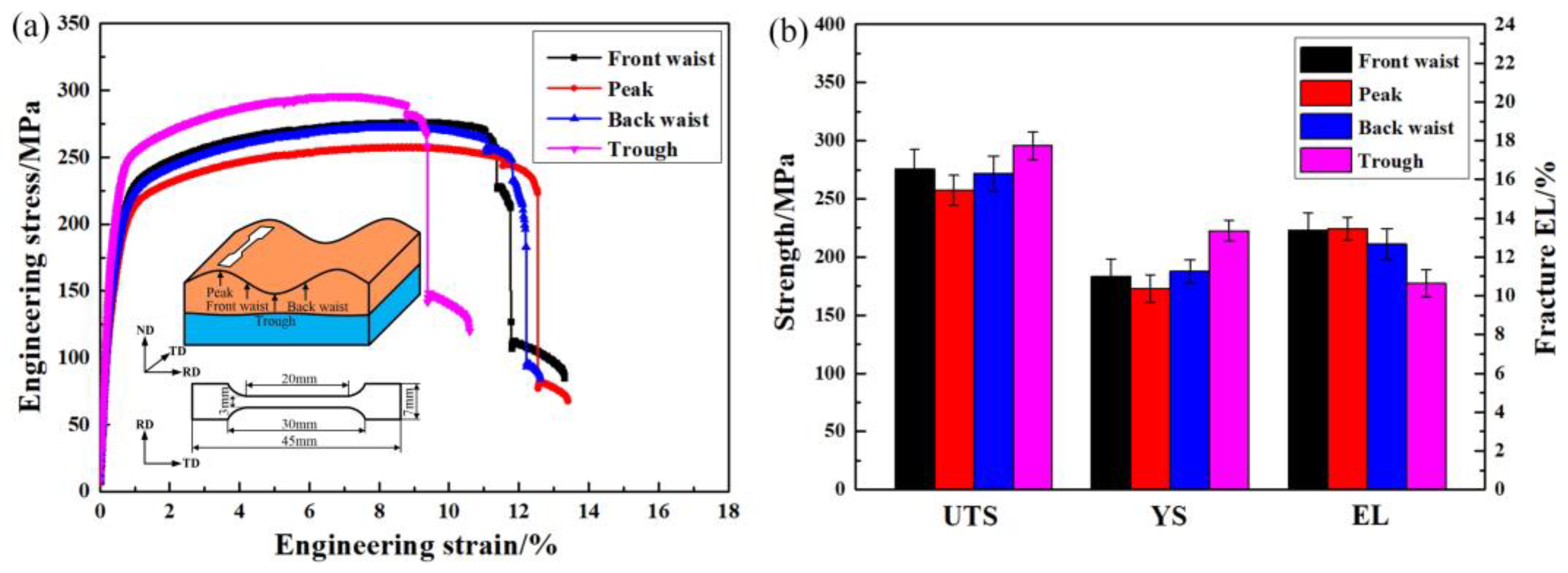
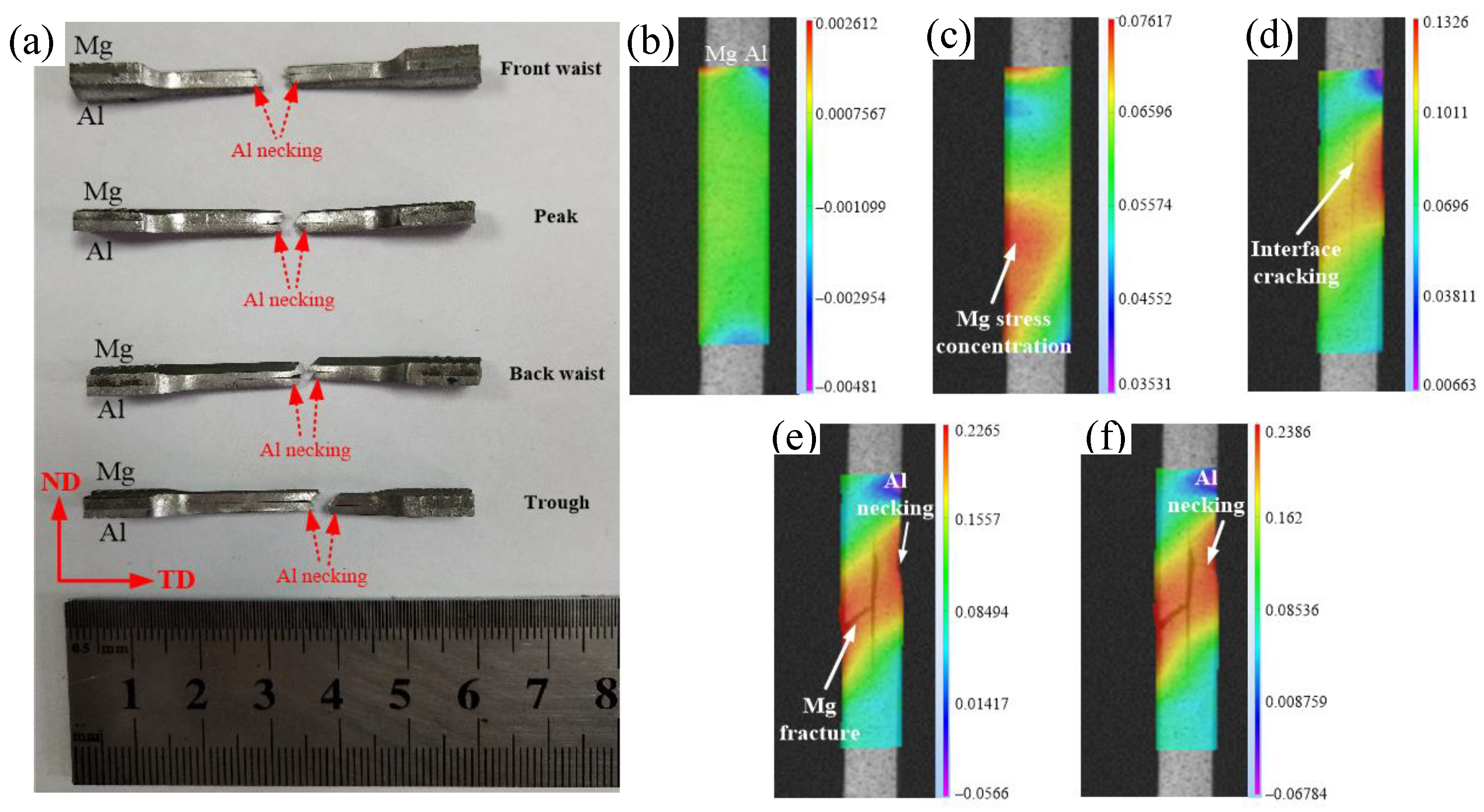

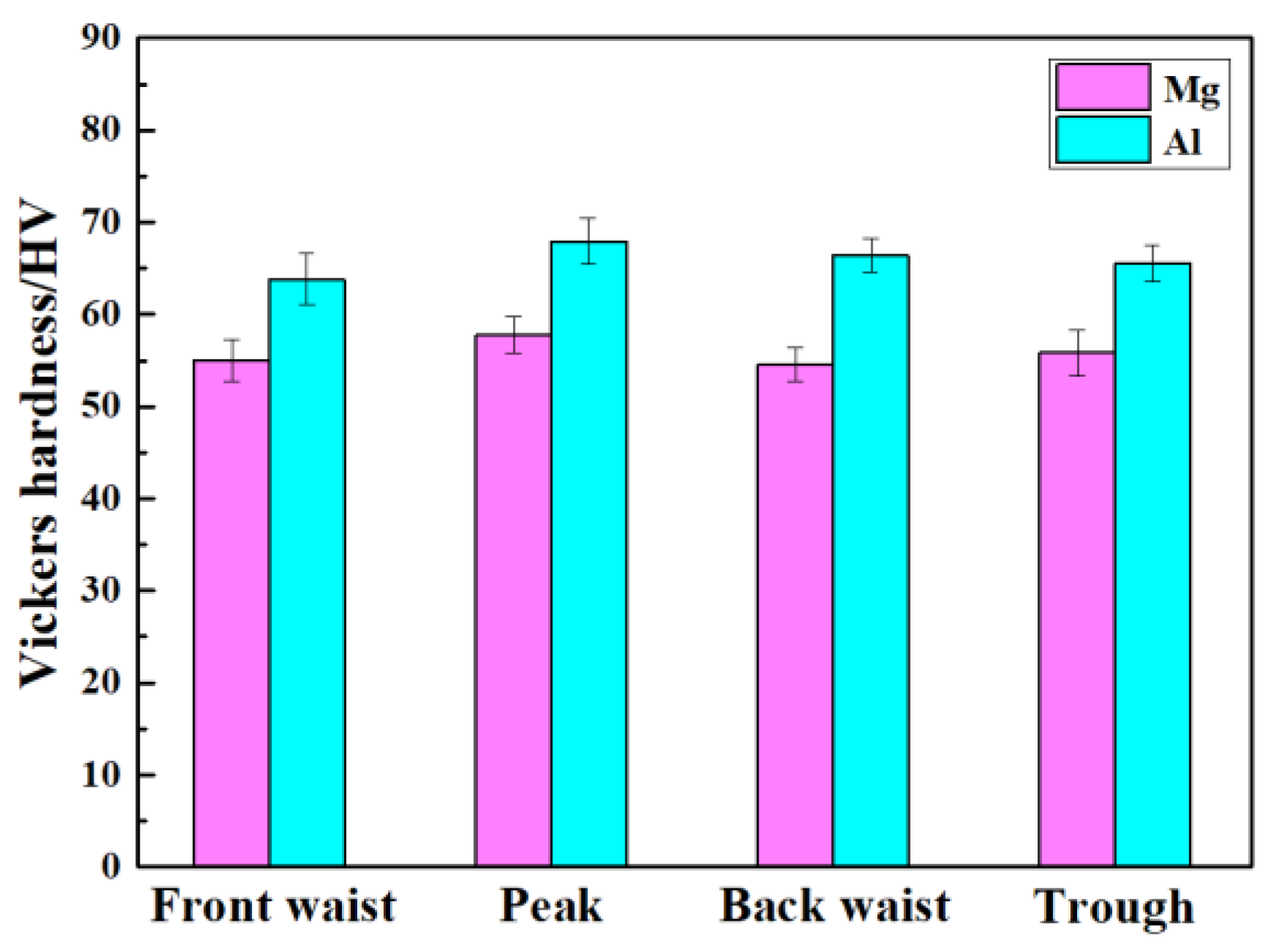
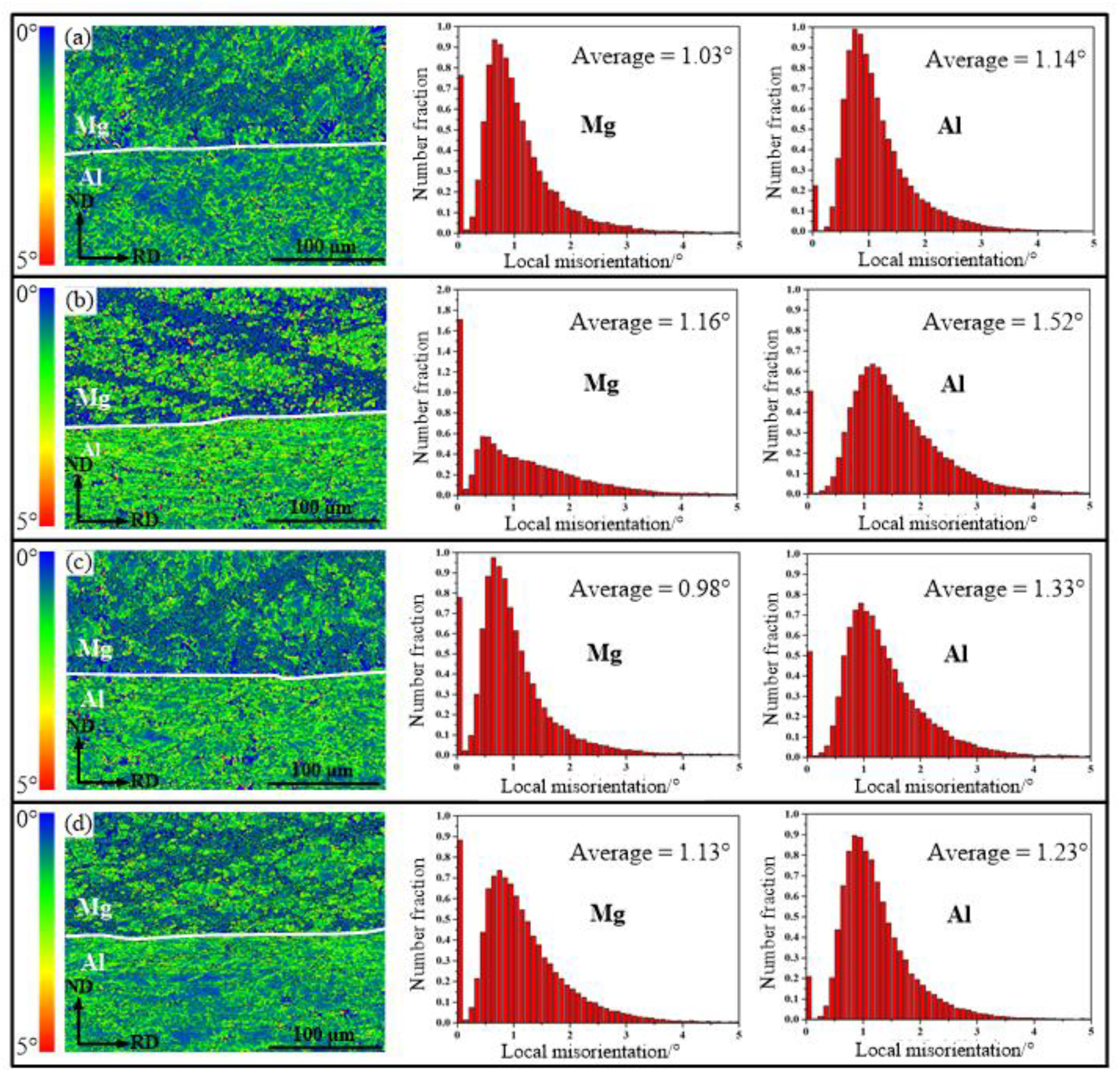
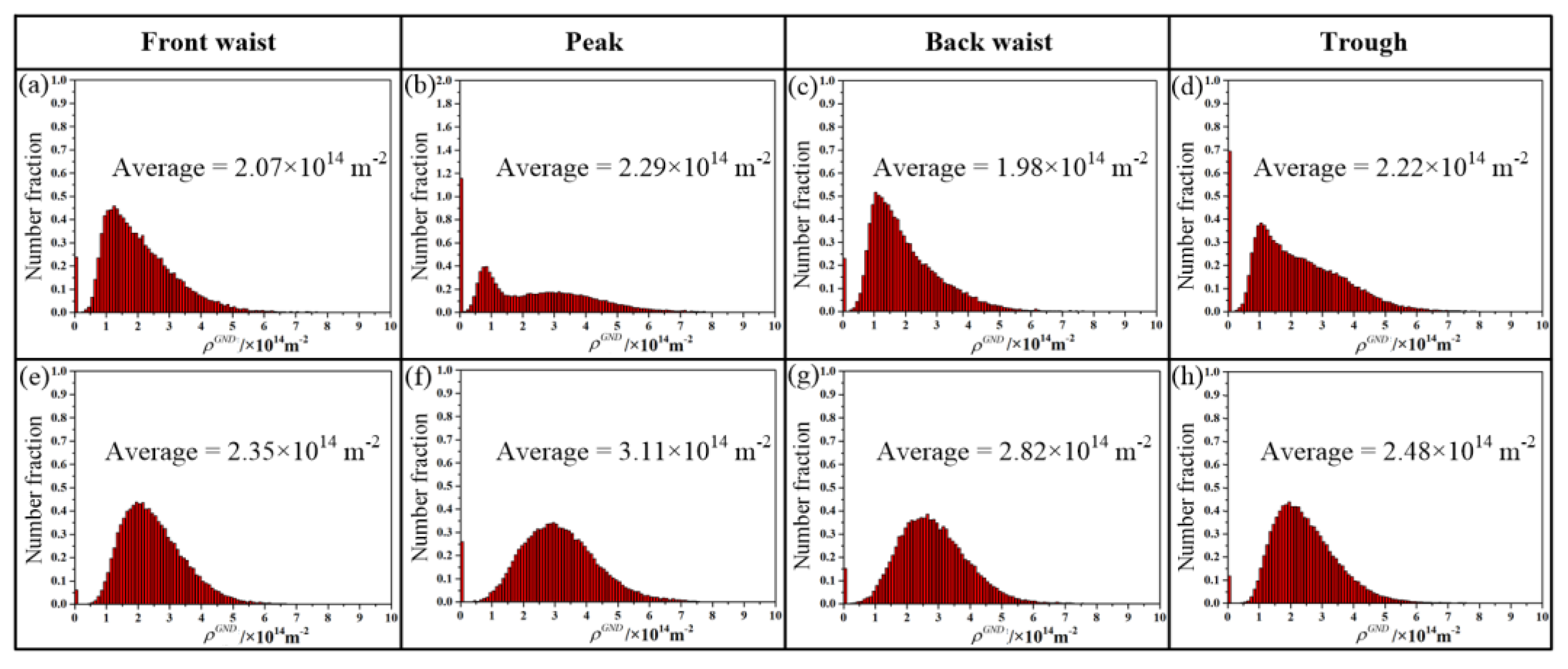


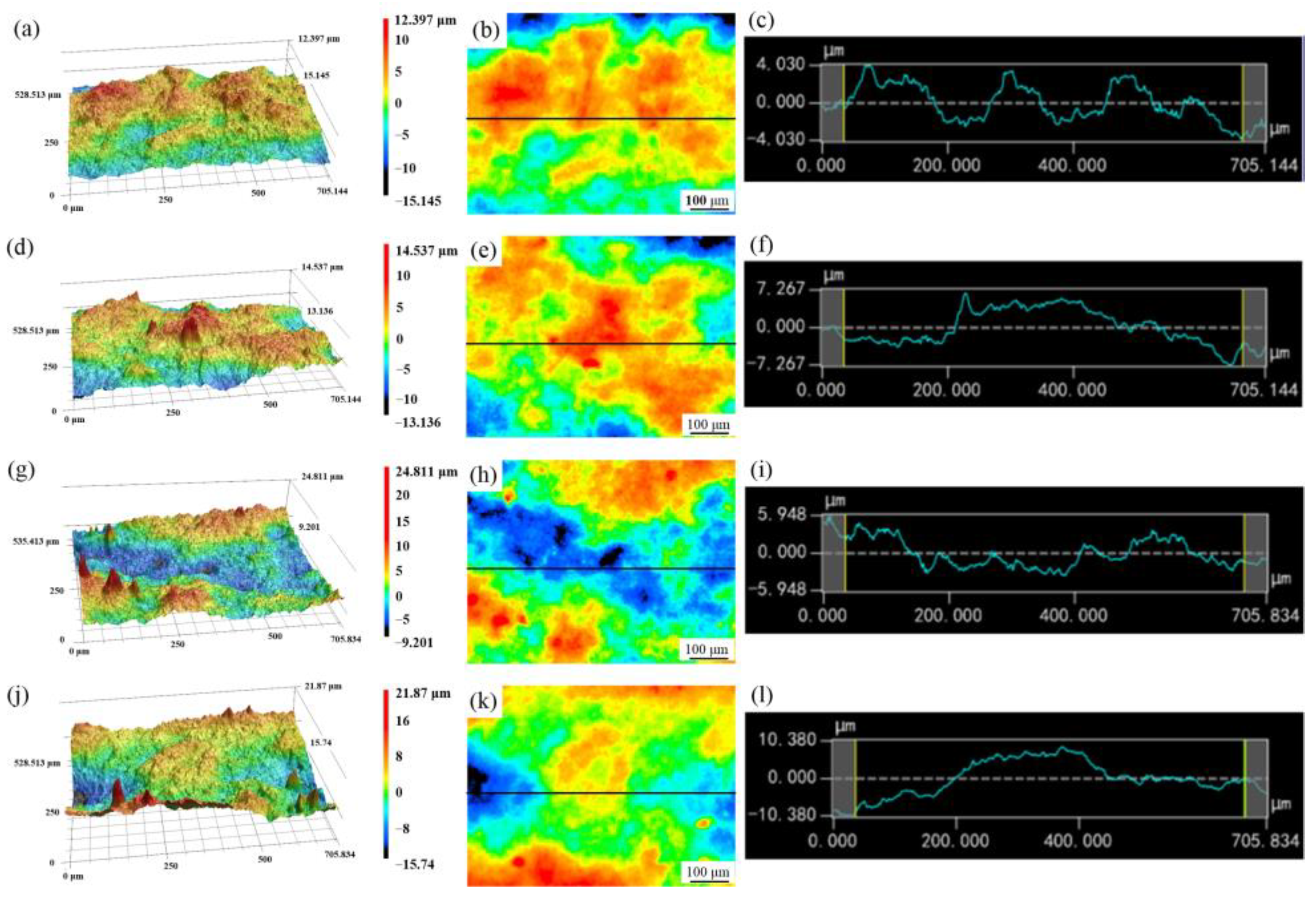

| Materials | Mg | Cu | Ca | Mn | Si | Al | Zn | Cr | Fe |
|---|---|---|---|---|---|---|---|---|---|
| Mg sheet | balance | 0.01 | 0.04 | 0.8 | 0.07 | 3.2 | 1.2 | − | − |
| Al sheet | 2.2–2.8 | 0.1 | − | 0.1 | 0.25 | balance | 0.1 | 0.15–0.35 | 0.4 |
| Positions | UTS (MPa) | YS (MPa) | Fracture EL (%) | YS/UTS |
|---|---|---|---|---|
| Front waist | 276 | 184 | 13.3 | 0.66 |
| Peak | 257 | 173 | 13.4 | 0.67 |
| Back waist | 272 | 188 | 12.6 | 0.69 |
| Trough | 296 | 223 | 10.6 | 0.75 |
| Roughness | Front Waist | Peak | Back Waist | Trough |
|---|---|---|---|---|
| Ra | 4.41 μm | 2.14 μm | 2.41 μm | 2.14 μm |
| Sa | 3.99 μm | 3.16 μm | 3.39 μm | 4.43 μm |
| Roughness | Front Waist | Peak | Back Waist | Trough |
|---|---|---|---|---|
| Ra | 1.66 μm | 3.01 μm | 1.84 μm | 3.69 μm |
| Sa | 3.21 μm | 2.80 μm | 3.12 μm | 3.60 μm |
Disclaimer/Publisher’s Note: The statements, opinions and data contained in all publications are solely those of the individual author(s) and contributor(s) and not of MDPI and/or the editor(s). MDPI and/or the editor(s) disclaim responsibility for any injury to people or property resulting from any ideas, methods, instructions or products referred to in the content. |
© 2023 by the authors. Licensee MDPI, Basel, Switzerland. This article is an open access article distributed under the terms and conditions of the Creative Commons Attribution (CC BY) license (https://creativecommons.org/licenses/by/4.0/).
Share and Cite
Zhao, S.; Hu, Y.; Li, S.; Wang, T. Mechanical Properties and Bonding Mechanism of the Mg/Al Clad Sheet Manufactured by the Corrugated Roll. Metals 2023, 13, 503. https://doi.org/10.3390/met13030503
Zhao S, Hu Y, Li S, Wang T. Mechanical Properties and Bonding Mechanism of the Mg/Al Clad Sheet Manufactured by the Corrugated Roll. Metals. 2023; 13(3):503. https://doi.org/10.3390/met13030503
Chicago/Turabian StyleZhao, Shi, Yaoqing Hu, Sha Li, and Tao Wang. 2023. "Mechanical Properties and Bonding Mechanism of the Mg/Al Clad Sheet Manufactured by the Corrugated Roll" Metals 13, no. 3: 503. https://doi.org/10.3390/met13030503
APA StyleZhao, S., Hu, Y., Li, S., & Wang, T. (2023). Mechanical Properties and Bonding Mechanism of the Mg/Al Clad Sheet Manufactured by the Corrugated Roll. Metals, 13(3), 503. https://doi.org/10.3390/met13030503





